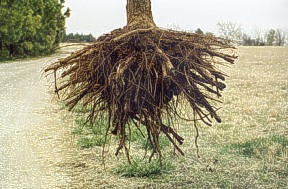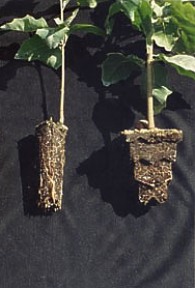Starting Seedlings Right
by Dr. Carl Whitcomb
Seedling development: The critical first few days

Many plant propagators are missing a golden opportunity to improve their crops. Shortly after seed germination, they have a one-time chance to improve the ultimate root and shoot structure of their trees.
When a seed germinates in the wild, a strong primary or taproot plunges downward. The tip of the taproot has strong apical dominance that suppresses secondary root branching in the same manner that the tip of a new shoot suppresses production of side branches.
The objective of the taproot is to extend deeply to anchor the new plant and to access moisture to avoid dehydration. The objective of the new shoot is to reach sufficient vertical height to access light to support leaf functions and to avoid being overshadowed by the competition.
Tops and Bottoms
The response of a typical tree seedling's top is to develop few, if any, side branches until leaves on the main stem are positioned in sunlight. Likewise, a typical response with the taproot is to produce few, if any, branch roots until the taproot has extended a considerable distance (often three feet or more) and provisions for the plant have been secured.
Since there are limited energy resources stored in the seed, the young plant proceeds most efficiently: Only after the taproot is secured and is providing water and nutrients, and the new leaves are producing energy, does the secondary branching begin both above and below ground.
Nursery conditions are very different from those in nature, as moisture and nutrients are provided and competing weeds are controlled. There is no need for a deep taproot. In fact, in a nursery a deep taproot is a liability not an asset. This is because shallow horizontal roots are the prime providers of nutrients to the leaves, since they are in the zone of the soil where both oxygen and nutrients are most plentiful.
Generating Secondary Roots
When root pruning occurs at the proper time and position, horizontal
secondary roots are produced and it is highly desirable to maintain these
roots in horizontal growth.
|
Trees grown with such procedures produce roots radially as well as downward following transplanting, accelerating establishment, and stimulating top growth and overall plant health. Such desirable root systems can be created consistently by air root pruning (dehydration pruning) the tip of the taproot approximately four inches below the seed. This stimulates secondary branch-root formation along the entire short taproot. |
 |
Pruning the taproot later will stimulate formation of secondary roots at the face of the point of pruning, much like the development of roots from the cut ends on a tree harvested balled-in-burlap, but only there and never up and down the vertical axis of the root below the soil surface.
There is but one opportunity to stimulate secondary branch-roots at this critical juncture. If it is missed, it is gone for ever. But even if provisions are made to stimulate secondary root growth, little is gained unless the roots are encouraged to continue their horizontal growth.
The challenge is to find a way to maintain this horizontal growth. In bottomless milk cartons, plastic tubes or sleeves and open bottom plug trays, there is no opportunity for this to occur. These types of containers deflect all secondary branch-roots downwards, leaving few, if any, roots to grow horizontally following transplanting. Trees grown in plug or milk carton type containers then planted into larger containers promptly develop a complex mat of roots at the bottom and modest roots above. When these trees are planted in the field, most roots extend downward, further reducing the amount in the root ball when harvested balled-in-burlap or with tree spades.
 |
In 1987 it occurred to me that the way to improve root branching and horizontal growth was to create a seedling container that air-root-pruned at several levels on the sides as well as at the bottom. The result was the RootMaker®, an injection molded pot 2.5 x 2.5 x 4 inches deep with saw-tooth like ledges and slits in the sides and four openings in the bottom. RootMaker® II followed, a 32-cell tray of similar design that accomplishes the same air-pruning at all levels. |
Seeds planted in these containers develop roots in all directions following transplanting, not just downward. We have shown that trees that develop large numbers of roots at the root-stem junction and along the short vertical taproot just below it, consistently grow faster than trees with fewer roots arising in this critical region.
Conclusion
With timely air-root-pruning of seedlings and provision for continued horizontal root development, trees can consistently be produced with compact fibrous root systems whether grown in containers or in the field. Not only do trees grown in this way require little or no staking, they establish more quickly following transplanting, and, with a vast array of smaller roots, no one root is likely to increase in diameter to the point of causing problems in the landscape as they age.
On to see the results of this method in pictures
Back to the Table of Contents